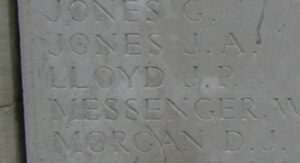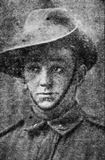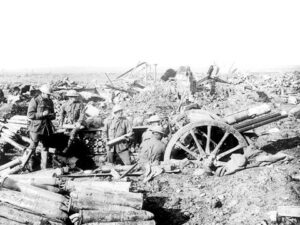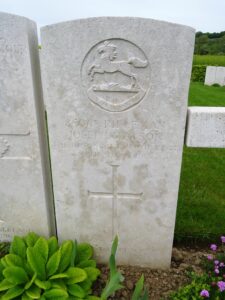Llangynllo, or Llangunllo, is a village and community in Radnorshire, situated about five miles west of Knighton. The village is names after Saint Cynllo, and it has its own railway station. The village war memorial is in the form of a cross inset with a sword of sacrifice. The plinth beneath contains two plaques, which list the men of Llangynllo who fell during both World Wars.
The Great War, 1914-1918
Frank Harvey Deakins, Private, 238547, King’s Shropshire Light Infantry. Frank was the son of William Deakins, of Rock Villa, Llangynllo. He Worked at his brother Arthur’s farm prior to the war when he enlisted into the Herefordshire Regiment. Frank was then posted to the 4th Battalion, King’s Shropshire Light Infantry. The battalion had spent much of the war in Singapore and Hong Kong before landing back at Plymouth on 27 July 1917. It then re-embarked at Southampton and landed at Le Havre on 29 July, and moved to Ypres to join 190 Brigade, 63rd (Royal Naval) Division. Frank would have seen his first action during the divisions assault on Passchendaele Ridge during the Third Battle of Ypres. The Divisions next major action was at Cambrai, during the Action of Welch Ridge, and it was still in the area when the Germans launched their Spring Offensive on 21 March 1918. In August, the Division took part in the Battle of Albert, which marked the beginning of the great offensive which was to end the war, and took part in the Battle of Drocourt-Queant, the Battle of the Canal du Nord and the Battle of Cambrai, before forcing the Passage of the Grand Honelle. The Division was demobilised in France by April 1919. Frank had survived the war and returned home to Llangynllo, but his health was shattered by his military service and he died on 7 August 1922, aged 24. Frank is not commemorated by the CWGC, and is not named on the memorial. Two of his brothers fell during the war.
Robert Deakins, Private, 34226, Dorsetshire Regiment. Robert was the son of William Deakins, of Rock Villa, Llangynllo. He was a drapers assistant and lived at 14, Monday Market Street, Devizes by 1911. In 1914 he married Cecilia May Oliver, and the couple had two daughters, Barbara and Audrey. Robert enlisted at Redhill, Surrey into the Army Service Corps, but upon being posted to France, joined the 1st Battalion, Dorsetshire Regiment. The battalion was attached to 14 Brigade, 32nd Division and had been in France since 16 August 1914. Robert joined up with the battalion at some time in 1916, probably during the Battle of the Somme. During March 1917 the division followed the German Retreat to the Hindenburg Line. It did not take part in any major actions in 1917, but on 21 March 1918 became caught up in the German offensive, before being moved to the southern Somme sector. Following the epic Australian success at Villers Bretonneux on 8 August, the division took part in the Battle of Albert on 21 August. From here on the Allies were on the offensive, and the Division pushed forwards along the Amiens to Péronne road, from the village of Harbonnières. By the morning of 29 September 1918, the 32nd Division was on the Le Helene Ridge, overlooking the town of Bellenglise, a strongly defended position on the Canal du Nord. At 10.00 the 1st Dorset’s crossed the canal at Bellenglise under heavy shellfire, before attacking Fleche Wood. Robert was killed during the attack that day. He was 28 years old and is buried in Bellicourt British Cemetery, France. His brother William had been killed three months previously, whilst another brother, Frank died in 1922.
William Deakins, MM, Lance Bombardier, 13238, Royal Field Artillery. William was the son of William Deakins, of Rock Villa, Llangynllo. He worked as a shop assistant prior to enlisting at Newport, Mon into the Royal Field Artillery, and landed in Le Havre, France with ‘A’ Battery, 76th Brigade, RFA on 2 September 1915. The battery was attached to the 16th (Irish) Division which concentrated in the Bethune area. The division saw its first major action during the Somme Offensive, at the Battle of Guillemont, and also fought at the Battle of Ginchy. By May 1917 the Division had moved to positions south of Ypres, where it fought at the Battle of Messines, and then moved north, fighting at the Battle of Langemarck. At the beginning of 1917 the Division was stationed near St. Quentin. It was hit here by the German Spring Offensive of 21 March 1918 and took part in the heavy fighting which ultimately stemmed the German offensive. William was killed in action just prior to the breaking up of the badly depleted division, on 20 June 1918, aged 27. He is buried in Bellacourt Military Cemetery, Riviere, France. He had been awarded the Military Medal for Bravery in the Field for his work during the Battle of the Somme. His brother Robert was killed just three months later, while another brother Frank died in 1922.
David Isaiah Lloyd, Private, 17552, King’s Shropshire Light Infantry. David was the son of John and Sarah Lloyd, of Old House, Llangynllo. He worked as a waggoner at Llandegley prior to enlisting at Knighton into the 5th Battalion, King’s Shropshire Light Infantry. The battalion landed in France on 20 May 1915 attached to 42 Brigade, 14th Division and moved to positions at Ypres. The Division was to see its first action during the Action of Hooge, where it became the first to be attacked by the German use of flamethrowers. It then fought in the Second attack on Bellewaarde. The battalion had been in the line near the Menin Road throughout August, and as a diversion to the main offensive at Loos which was to take place from 25 September 1915, the 14th Division had been given the task of attacking Bellewaarde. The 5th KSLI, together with the remainder of 42 Brigade, was tasked with seizing Bellewaarde Farm. The British launched an artillery bombardment at 3.50, then at 4.20 the attacking battalions advanced behind a creeping barrage. Some of the brigades objectives were reached, but a German counter-attack pushed them back to their starting positions, after incurring heavy casualties. David was among 450 casualties suffered just by the 5th KSLI that day. The 24-year-old has no known grave and is commemorated on the Menin Gate Memorial, Ypres. Tragically, his brother, John, was killed at Loos that same day.
John Pryce Lloyd, Corporal, 13868, Welsh Regiment. John was the son of John and Sarah Lloyd, of Old House, Llangynllo. He worked as a railway platelayer prior to enlisting at Neath into the 9th Battalion, Welsh Regiment soon after the outbreak of war. The battalion was attached to 58 Brigade, 19th (Western) Division and moved to France on 18 July 1915, taking up positions near Festubert and Givenchy. The Allies had planned a large-scale offensive at Loos, which would take place under cover of a release of poison gas, and the 19th Division had been tasked with a diversionary attack from their positions to the north. At dawn on 25 September 1915 the men of the division climbed out of their trenches and began the advance over No Man’s Land, but were immediately met by heavy machine-gun fire from the Germans. Casualties among all of the attacking battalions of the division were heavy, but the 9th Welsh had been hit particularly hard, suffering four officers and 57 other ranks killed, nine officers and 140 other ranks wounded. John was 27 years old when he was killed that morning. He has no known grave and is commemorated on the Loos Memorial, France. Tragically, his brother David was killed at Ypres that same day.

Edward Poole, Driver, 2067, Australian Field Artillery. Edward was the son of Edward and Martha Poole, of Pyccorner Llangynllo. He worked as a shepherd on his parents farm prior to emigrating to Australia in 1912 and worked as a teamster prior to enlisting at Blackboy Hill into the 10th Light Horse on 9 October 1915. He embarked at Fremantle aboard HMAT Warilda on 16 February 1916 and joined his unit at Serapeum, Egypt. With the Gallipoli campaign being over, the Australian Imperial Force was being readied to move to France, while the Light Horse would remain in Egypt with the EEF, so Edward transferred to the 4th Divisional Ammunition Column, Australian Field Artillery, and moved to France. He took part in the Australians attack on Pozieres Ridge and Mouquet Farm, during the Somme offensive, before taking ill and being sent to Middlesex War Hospital in England. By 19 June 1917 he had recovered and was back in France, where he was posted to the 10th Brigade, Australian Field Artillery. The Brigade had moved to Ypres with the 4th Australian Division to assist with artillery support for the offensive on Passchendaele Ridge. Edward was stationed at Ypres with the battery when he was killed on 8 October 1917, aged 28. He is buried in Ypres Town Cemetery Extension, Belgium.


Arthur Price, MM, Corporal, 25727, Royal Field Artillery. Arthur was the son of Charles and Mary Ann Price, of Brook House, Llangynllo. He married Mary Elizabeth Evans, of 4, Boot Street, Welshpool in about 1909, but lived and worked with his brother Albert as a coal hewer at Bargoed prior to the war. Mary joined him in Bargoed just before the war, but when he enlisted into the Royal Field Artillery, moved back to Welshpool with their children. Arthur landed in France with ‘X’ Battery, 2nd Trench Mortar Battery, Royal Field Artillery on 1 March 1915. The battery was equipped with the 1.5” mortar and was attached to the 7th Division. Arthur would have seen action during the Battles of Neuve Chapelle and Aubers Ridge soon after joining the battery, and would have taken part in the Battle of Loos from 25 September onwards. Arthur was killed in action on 11 June 1916 when a German shell hit some fused shells his gun-crew had prepared ready to fire. He was 29 years old and is commemorated on the Arras Memorial, France. He is also commemorated on the Welshpool War Memorial. He was awarded the Military Medal for bravery in the field, one of the earliest awards, for his actions prior to the Battle of the Somme, for remaining at his gun for six hours under very heavy shellfire on 1 June 1916.

Joseph Watson, Private, 85068, The King’s (Liverpool Regiment). Joseph was the son of Thomas and Annie Eliza Watson, of Crungoed Cottage, Llanbister Road. He enlisted at Knighton into the army and served with the 17th Lancers before being transferred to the 1/6th Battalion, The King’s (Liverpool) Regiment, which was attached to 165 Brigade, 55th Division. He most likely joined the battalion following its rebuild in December 1917. The division had been almost annihilated during the German counter-attack at Cambrai on 30 November 1917. It was withdrawn from the area and sent to Bomy, near Fruges for intensive training. The Division relieved 42nd (East Lancashire) Division in the front line at Givenchy and Festubert on 15 February, and faced numerous strong enemy raids in March. April was at first much quieter, but it was a lull before the storm, as the Germans launched another offensive here, with the Division took part in the Battle of Estaires, successfully fighting at the First Defence of Givenchy, the single most famous action that the Division fought. Joseph survived all of this terrible fighting but sadly took ill and died of disease whilst the battalion was in the Festubert area, on 4 June 1918, aged 20. He is buried in Pernes British Cemetery, France.

World War Two, 1939-1945
George Reynolds, Gunner, 821436, Royal Artillery. George was the son of John and Emma Reynolds, of Noyadfach, Knighton. He was the husband of Eileen Mary Reynolds, of Wellington, Shropshire. George had enlisted into the Royal Artillery at Shrewsbury on 25 June 1932 and following the outbreak of war was posted to the Far East with 92 Field Regiment, Royal Artillery. The battery had been in France with the BEF at the outbreak of war and had covered the withdrawal of the BEF across the Ypres-Comines canal back to Dunkirk. After being evacuated the battery remained on home service until being despatched to the Far East in March 1942, moving to Ranchi. George died at Ranchi on 9 September 1942, aged 31. He is buried in Ranchi War Cemetery, India. The battery moved to Persia soon afterwards, before returning to Europe to take part in the landings at Sicily.